Potential of Earth Observation for the German North Sea Coast—A Review
Abstract
1. Introduction
1.1. German North Sea Coast
1.2. Climate Change and the German North Sea Coasts
1.3. Remote Sensing of Coasts
1.4. Aim
2. Materials and Methods
3. Results
3.1. Distribution of Papers Across Journals and Regions
3.2. Overarching Topics and Years
3.3. Platforms, Sensors, and Data Types
3.4. Temporal and Spatial Scale and Resolution
3.5. Methods
3.6. Research Sub-Topics
3.6.1. Coastal Morphology
3.6.2. Water Quality
3.6.3. Ecology
3.6.4. Sediment
4. Discussion
4.1. Study Area and Scale Gaps
4.2. Potential for Densification of Time Series
4.3. Underutilized Platforms and Sensors
4.4. Processing and Analysis Methods
4.5. Topical Gaps
4.6. Application to Other Areas
4.7. Scientific Transfer
5. Conclusions and Outlook
- Authorship of the papers in this review is highly localized, with ninety-one percent of these papers coming from five countries that share the North Sea coastline (Germany, Netherlands, United Kingdom, Denmark, Belgium).
- Water quality and coastal morphology studies were the most numerous topics, nearly equal to each other and together making up almost 70% of papers. Ecology followed closely and few sediment studies (8%) occurred.
- About half of studies (49%) were multitemporal and multiannual, largely due to water quality studies, of which over three quarters were multitemporal and multiannual. Further, water quality and sediment studies most frequently investigated sub-annual (i.e., seasonal) patterns. In contrast, coastal morphology studies more frequently focused on monotemporal and multiannual timescales and reveal a major gap in long-running time series with sub-annual temporal resolution.
- Multispectral was the most common data type by far (58%), but SAR was also fairly frequently used (23%). Satellite sensors were most frequently used compared to aircrafts and UAVs, which collected the majority of very-high-resolution data. Very few high- or very-high-resolution satellite sensors (e.g., Sentinel-2, Sentinel-1, Planet) were used by studies in this review despite their increasing availability, although, in general, very-high-resolution data use has increased since about 2013. Such sensors would be particularly helpful for discerning highly dynamic patterns characteristic of coastal areas.
- The size of study area correlated positively with pixel size, with studies clustering by topic. Where coastal morphology and ecology studies were limited in spatial extent, water quality and sediment studies were limited in spatial resolution. Further, more than half of studies focused on sub-national study area scales, with nearly 30% of studies focusing on site-scale areas, and a quarter considered island, state, or regional scales. About 40% of studies considered national or larger study areas. Despite the prolific number of local scale studies, the proportion of studies at this scale has increased in the past ten years, while the proportion of state/regional or national studies has decreased. This review demonstrates a need for high spatial resolution water quality studies as well as large-area coastal morphology and ecology studies.
- Research questions varied broadly, categorized into 30 sub-topics that span bathymetry, topography, vertical land motion, land cover and land use, SST, ocean color, modeling and forecasting, coastal erosion and flooding, shoreline changes, and marine ecosystem shifts. Intertidal topography was the largest sub-topic overall, representing nearly a quarter of papers, followed distantly by bivalves (7%), marshes (6%), and chlorophyll (6%). Paper topics generally align with previous reviews on remote sensing for coastal hazards more broadly, demonstrating an extensive range of critical applications in coastal zone characterization, monitoring hazard variables, and monitoring coastal hazards. However, some topics that were minimally addressed—specifically, vertical land motion, land cover and land use, forecasting, coastal erosion, and flooding—represent topical gaps.
- Future studies on this topic that align with management areas, such as one of the coastal states, the German Wadden Sea National Parks, or the Wadden Sea World Heritage site as a whole, would be relevant to coastal management practices.
Author Contributions
Funding
Data Availability Statement
Acknowledgments
Conflicts of Interest
References
- Liquete, C.; Zulian, G.; Delgado, I.; Stips, A.; Maes, J. Assessment of Coastal Protection as an Ecosystem Service in Europe. Ecol. Indic. 2013, 30, 205–217. [Google Scholar] [CrossRef]
- Paprotny, D.; Terefenko, P.; Giza, A.; Czapliński, P.; Vousdoukas, M.I. Future Losses of Ecosystem Services Due to Coastal Erosion in Europe. Sci. Total Environ. 2021, 760, 144310. [Google Scholar] [CrossRef] [PubMed]
- Reise, K.; Baptist, M.; Burbridge, P.; Dankers, N.; Fischer, L.; Flemming, B.; Oost, A.P.; Smit, C. The Wadden Sea—A Universally Outstanding Tital Wetland. In Wadden Sea Ecosystem; Common Wadden Sea Secretariat: Wilhelmshaven, Germany, 2010; pp. 7–24. [Google Scholar]
- Benninghoff, M.; Winter, C. Recent Morphologic Evolution of the German Wadden Sea. Sci. Rep. 2019, 9, 9293. [Google Scholar] [CrossRef]
- Schückel, U.; Kröncke, I. Temporal Changes in Intertidal Macrofauna Communities over Eight Decades: A Result of Eutrophication and Climate Change. Estuar. Coast. Shelf Sci. 2013, 117, 210–218. [Google Scholar] [CrossRef]
- Trilateral Wadden Sea Cooperation|Wadden Sea. Available online: https://www.waddensea-worldheritage.org/trilateral-wadden-sea-cooperation (accessed on 4 February 2025).
- Lotze, H.K.; Reise, K.; Worm, B.; Van Beusekom, J.; Busch, M.; Ehlers, A.; Heinrich, D.; Hoffmann, R.C.; Holm, P.; Jensen, C.; et al. Human Transformations of the Wadden Sea Ecosystem through Time: A Synthesis. Helgol. Mar. Res. 2005, 59, 84–95. [Google Scholar] [CrossRef]
- Schulte, I.; Rodermund, H.; Selvam, H.; Becker, J.; Schweiger, C.; Schürenkamp, D.; Goseberg, N.; Schüttrumpf, H. Inventory of Transitions on Sea Dikes at the German Coast: Spatial Analysis, Design and Damages. Front. Built Environ. 2024, 10, 1–22. [Google Scholar] [CrossRef]
- Winterwerp, J.C.; Wang, Z.B. Man-Induced Regime Shifts in Small Estuaries—I: Theory. Ocean Dyn. 2013, 63, 1279–1292. [Google Scholar] [CrossRef]
- Blossier, B.; Bryan, K.R.; Daly, C.J.; Winter, C. Spatial and Temporal Scales of Shoreline Morphodynamics Derived from Video Camera Observations for the Island of Sylt, German Wadden Sea. Geo Mar. Lett. 2017, 37, 111–123. [Google Scholar] [CrossRef]
- Hayes, M. Morphology of Sand Accumulation in Estuaries: An Introduction to the Symposium. In Estuarine Research; Academic Press: New York, NY, USA, 1975; Volume 2, pp. 3–22. [Google Scholar]
- EMODnet Bathymetry Consortium. EMODnet Digital Bathymetry (DTM 2022); EMODnet Bathymetry Consortium: Venice, Italy, 2022. [Google Scholar]
- Kuratorium für Forschung im Küsteningenieurwesen. Die Küste: Archiv für Forschung und Technik an der Nord—und Ostsee; Die Küste; Boyens Medien: Heide, Germany, 2008; ISBN 978-3-8042-1065-3. [Google Scholar]
- MacManus, K.; Balk, D.; Engin, H.; McGranahan, G.; Inman, R. Estimating Population and Urban Areas at Risk of Coastal Hazards, 1990–2015: How Data Choices Matter. Earth Syst. Sci. Data 2021, 13, 5747–5801. [Google Scholar] [CrossRef]
- McGranahan, G.; Balk, D.; Anderson, B. The Rising Tide: Assessing the Risks of Climate Change and Human Settlements in Low Elevation Coastal Zones. Environ. Urban. 2007, 19, 17–37. [Google Scholar] [CrossRef]
- Kulp, S.A.; Strauss, B.H. New Elevation Data Triple Estimates of Global Vulnerability to Sea-Level Rise and Coastal Flooding. Nat. Commun. 2019, 10, 4844. [Google Scholar] [CrossRef] [PubMed]
- Sabour, S.; Brown, S.; Nicholls, R.J.; Haigh, I.D.; Luijendijk, A.P. Multi-Decadal Shoreline Change in Coastal Natural World Heritage Sites—A Global Assessment. Environ. Res. Lett. 2020, 15, 104047. [Google Scholar] [CrossRef]
- Neumann, B.; Vafeidis, A.T.; Zimmermann, J.; Nicholls, R.J. Future Coastal Population Growth and Exposure to Sea-Level Rise and Coastal Flooding—A Global Assessment. PLoS ONE 2015, 10, e0118571. [Google Scholar] [CrossRef]
- Lamb, H. Historic Storms of the North Sea, British Isles and Northwest Europe; Cambridge University Press: Cambridge, UK, 1991. [Google Scholar]
- Port of Hamburg at a Glance: Facts and Figures. Available online: https://www.ihk.de/hamburg/en/produktmarken/economic/port-hamburg-fact-figures-1147536 (accessed on 30 January 2025).
- European Union’s Copernicus Land Monitoring Service information CORINE Land Cover 2018 (Vector/Raster 100 m), Europe, 6-Yearly. Available online: https://land.copernicus.eu/en/products/corine-land-cover/clc2018 (accessed on 8 January 2025).
- Beck, H.E.; Zimmermann, N.E.; McVicar, T.R.; Vergopolan, N.; Berg, A.; Wood, E.F. Present and Future Köppen-Geiger Climate Classification Maps at 1-Km Resolution. Sci. Data 2018, 5, 180214. [Google Scholar] [CrossRef]
- Błażejczyk, K.; Baranowski, J.; Jendritzky, G.; Błażejczyk, A.; Bröde, P.; Fiala, D. Regional Features of the Bioclimate of Central and Southern Europe against the Background of the Köppen-Geiger Climate Classification. Geogr. Pol. 2015, 88, 439–453. [Google Scholar] [CrossRef]
- Wetter Und Klima—Deutscher Wetterdienst—Our Services—Climate Data for Direct Download. Available online: https://opendata.dwd.de/climate_environment/CDC/observations_germany/climate/multi_annual/mean_91-20/ (accessed on 15 January 2025).
- Die Niedersächsischen Hauptdeichverbände|Nds. Landesbetrieb Für Wasserwirtschaft, Küsten- Und Naturschutz. Available online: https://www.nlwkn.niedersachsen.de/startseite/hochwasser_kustenschutz/kustenschutz/hauptdeichverbande/die-niedersaechsischen-hauptdeichverbaende-38937.html (accessed on 28 February 2025).
- Schleswig-Holstein.de—Küstenschutz—Generalplan Küstenschutz Des Landes Schleswig-Holstein—Fortschreibung 2022. Available online: https://www.schleswig-holstein.de/DE/fachinhalte/K/kuestenschutz/generalplanKuestenschutz (accessed on 6 March 2025).
- Bundesministerium für Umwelt, Naturschutz und Reaktorsicherheit (BMU) Integrated Coastal Zone Management in Germany: Assessment and Steps towards a National ICZM Strategy. Available online: http://spicosa-inline.databases.eucc-d.de/files/documents/00000659_IKZM_englisch_final.pdf (accessed on 6 March 2025).
- Lima, F.P.; Wethey, D.S. Three Decades of High-Resolution Coastal Sea Surface Temperatures Reveal More than Warming. Nat. Commun. 2012, 3, 704. [Google Scholar] [CrossRef]
- Høyer, J.L.; Karagali, I. Sea Surface Temperature Climate Data Record for the North Sea and Baltic Sea. J. Clim. 2016, 29, 2529–2541. [Google Scholar] [CrossRef]
- Reiners, P.; Obrecht, L.; Dietz, A.; Holzwarth, S.; Kuenzer, C. First Analyses of the TIMELINE AVHRR SST Product: Long-Term Trends of Sea Surface Temperature at 1 Km Resolution across European Coastal Zones. Remote Sens. 2024, 16, 1932. [Google Scholar] [CrossRef]
- Wahl, T.; Haigh, I.D.; Dangendorf, S.; Jensen, J. Inter-Annual and Long-Term Mean Sea Level Changes along the North Sea Coastline. J. Coast. Res. 2013, 165, 1987–1992. [Google Scholar] [CrossRef]
- Wahl, T.; Haigh, I.D.; Woodworth, P.L.; Albrecht, F.; Dillingh, D.; Jensen, J.; Nicholls, R.J.; Weisse, R.; Wöppelmann, G. Observed Mean Sea Level Changes around the North Sea Coastline from 1800 to Present. Earth Sci. Rev. 2013, 124, 51–67. [Google Scholar] [CrossRef]
- Reiners, P.; Holzwarth, S.; Dietz, A.; Bachmann, M.; Sobrino, J.A.; Kuenzer, C. Fusing AVHRR LST With Geostationary SEVIRI LST to Create a Long-Term Daily Maximum LST Time Series Over Europe. IEEE J. Sel. Top. Appl. Earth Obs. Remote Sens. 2025, 18, 2168–2189. [Google Scholar] [CrossRef]
- Das Helmholtz-Zentrum Hereon Nordseeküste: Bisherige Entwicklung Der Durchschnittlichen Temperatur Im Jahr 2023. Available online: https://www.norddeutscher-klimamonitor.de/klimaentwicklung/1961-2015/jahr/durchschnittliche-temperatur/nordseekueste/dwd-nkdz/zeitreihe.html (accessed on 30 January 2025).
- Dekker, R.; Beukema, J.J. Climate Warming Leads to Replacement of Limecola Balthica by Abra Tenuis on High Tidal Flats of the Wadden Sea. J. Sea Res. 2021, 178, 102137. [Google Scholar] [CrossRef]
- Rakhimberdiev, E.; Duijns, S.; Karagicheva, J.; Camphuysen, C.J.; Castricum, V.; Van Loon, A.; Wijker, A.; Keijl, G.; Levering, H.; Visser, J.; et al. Fuelling Conditions at Staging Sites Can Mitigate Arctic Warming Effects in a Migratory Bird. Nat. Commun. 2018, 9, 4263. [Google Scholar] [CrossRef]
- Van Regteren, M.; Meesters, E.H.; Baptist, M.J.; De Groot, A.V.; Bouma, T.J.; Elschot, K. Multiple Environmental Variables Affect Germination and Mortality of an Annual Salt Marsh Pioneer: Salicornia Procumbens. Estuaries Coasts 2020, 43, 1489–1501. [Google Scholar] [CrossRef]
- Deutscher Wetterdienst (DWD). Nationaler Klimareport; Deutscher Wetterdienst (DWD): Offenbach am Main, Germany, 2022; p. 53. [Google Scholar]
- Schuldt, C.; Schiewe, J.; Kröger, J. Sea-Level Rise in Northern Germany: A GIS-Based Simulation and Visualization. KN J. Cartogr. Geogr. Inf. 2020, 70, 145–154. [Google Scholar] [CrossRef]
- Philippart, C.J.M.; Baptist, M.J.; Bastmeijer, C.J.; Bregnballe, T.; Buschbaum, C.; Hoekstra, P.; Laursen, K.; van Leeuwen, S.M.; Oost, A.P.; Wegner, M.; et al. Wadden Sea Quality Status Report. In Wadden Sea Quality Status Report; Common Wadden Sea Secretariat: Wilhelmshaven, Germany.
- Deutscher Wetterdienst (DWD). Klimareport Niedersachsen; Deutscher Wetterdienst (DWD): Offenbach am Main, Germany, 2018; p. 52. [Google Scholar]
- Deutscher Wetterdienst (DWD). Klimareport Schleswig-Holstein; Deutscher Wetterdienst (DWD): Offenbach am Main, Germany, 2023; p. 68. [Google Scholar]
- Vousdoukas, M.I.; Ranasinghe, R.; Mentaschi, L.; Plomaritis, T.A.; Athanasiou, P.; Luijendijk, A.; Feyen, L. Sandy Coastlines under Threat of Erosion. Nat. Clim. Chang. 2020, 10, 260–263. [Google Scholar] [CrossRef]
- THE 17 GOALS|Sustainable Development. Available online: https://sdgs.un.org/goals (accessed on 6 March 2025).
- Weiss, D.J.; Walsh, S.J. Remote Sensing of Mountain Environments. Geogr. Compass 2009, 3, 1–21. [Google Scholar] [CrossRef]
- Murray, N.J.; Phinn, S.P.; Fuller, R.A.; DeWitt, M.; Ferrari, R.; Johnston, R.; Clinton, N.; Lyons, M.B. High-Resolution Global Maps of Tidal Flat Ecosystems from 1984 to 2019. Sci. Data 2022, 9, 542. [Google Scholar] [CrossRef]
- Vitousek, S.; Buscombe, D.; Vos, K.; Barnard, P.L.; Ritchie, A.C.; Warrick, J.A. The Future of Coastal Monitoring through Satellite Remote Sensing. Camb. Prism. Coast. Futures 2023, 1, e10. [Google Scholar] [CrossRef]
- Melet, A.; Teatini, P.; Le Cozannet, G.; Jamet, C.; Conversi, A.; Benveniste, J.; Almar, R. Earth Observations for Monitoring Marine Coastal Hazards and Their Drivers. Surv. Geophys. 2020, 41, 1489–1534. [Google Scholar] [CrossRef]
- Kordubel, K.; Baschek, B.; Hieronymi, M.; Voynova, Y.G.; Möller, K.O. Improving the Sampling of Red Noctiluca Scintillans to Understand Its Impact on Coastal Ecosystem Dynamics. J. Plankton Res. 2024, 46, 251–271. [Google Scholar] [CrossRef]
- El Serafy, G.Y.H.; Schaeffer, B.A.; Neely, M.-B.; Spinosa, A.; Odermatt, D.; Weathers, K.C.; Baracchini, T.; Bouffard, D.; Carvalho, L.; Conmy, R.N.; et al. Integrating Inland and Coastal Water Quality Data for Actionable Knowledge. Remote Sens. 2021, 13, 2899. [Google Scholar] [CrossRef] [PubMed]
- Hommersom, A.; Wernand, M.R.; Peters, S.; De Boer, J. A Review on Substances and Processes Relevant for Optical Remote Sensing of Extremely Turbid Marine Areas, with a Focus on the Wadden Sea. Helgol. Mar. Res. 2010, 64, 75–92. [Google Scholar] [CrossRef]
- Media Library|Integration and Application Network. Available online: https://ian.umces.edu/media-library/ (accessed on 31 January 2025).
- Freepik|Create Great Designs, Faster. Available online: https://www.freepik.com (accessed on 31 January 2025).
- Pirie, W. Spearman Rank Correlation Coefficient. In Encyclopedia of Statistical Sciences; Wiley-Interscience: New York, NY, USA, 2006. [Google Scholar]
- Luijendijk, A.; Hagenaars, G.; Ranasinghe, R.; Baart, F.; Donchyts, G.; Aarninkhof, S. The State of the World’s Beaches. Sci. Rep. 2018, 8, 6641. [Google Scholar] [CrossRef]
- Fricke, K.; Baschek, B.; Jenal, A.; Kneer, C.; Weber, I.; Bongartz, J.; Wyrwa, J.; Schöl, A. Observing Water Surface Temperature from Two Different Airborne Platforms over Temporarily Flooded Wadden Areas at the Elbe Estuary—Methods for Corrections and Analysis. Remote Sens. 2021, 13, 1489. [Google Scholar] [CrossRef]
- Die Nordfriesischen Halligen Im Überblick. Available online: https://halligen.de/halligwelt/halligen-erleben/halligen-im-ueberblick (accessed on 1 February 2025).
- D’Alimonte, D.; Melin, F.; Zibordi, G.; Berthon, J.-F. Use of the Novelty Detection Technique to Identify the Range of Applicability of Empirical Ocean Color Algorithms. IEEE Trans. Geosci. Remote Sens. 2003, 41, 2833–2843. [Google Scholar] [CrossRef]
- Adolph, W.; Farke, H.; Lehner, S.; Ehlers, M. Remote Sensing Intertidal Flats with TerraSAR-X. A SAR Perspective of the Structural Elements of a Tidal Basin for Monitoring the Wadden Sea. Remote Sens. 2018, 10, 1085. [Google Scholar] [CrossRef]
- Adolph, W.; Jung, R.; Schmidt, A.; Ehlers, M.; Heipke, C.; Bartholomä, A.; Farke, H. Integration of TerraSAR-X, RapidEye and Airborne Lidar for Remote Sensing of Intertidal Bedforms on the Upper Flats of Norderney (German Wadden Sea). Geo Mar. Lett. 2017, 37, 193–205. [Google Scholar] [CrossRef]
- Adolph, W.; Schückel, U.; Son, C.S.; Jung, R.; Bartholomä, A.; Ehlers, M.; Kröncke, I.; Lehner, S.; Farke, H. Monitoring Spatiotemporal Trends in Intertidal Bedforms of the German Wadden Sea in 2009–2015 with TerraSAR-X, Including Links with Sediments and Benthic Macrofauna. Geo Mar. Lett. 2017, 37, 79–91. [Google Scholar] [CrossRef]
- Brzank, A.; Heipke, C.; Goepfert, J.; Soergel, U. Aspects of Generating Precise Digital Terrain Models in the Wadden Sea from Lidar–Water Classification and Structure Line Extraction. ISPRS J. Photogramm. Remote Sens. 2008, 63, 510–528. [Google Scholar] [CrossRef]
- Capperucci, R.M.; Kubicki, A.; Holler, P.; Bartholomä, A. Sidescan Sonar Meets Airborne and Satellite Remote Sensing: Challenges of a Multi-Device Seafloor Classification in Extreme Shallow Water Intertidal Environments. Geo Mar. Lett. 2020, 40, 117–133. [Google Scholar] [CrossRef]
- Costas, I.; Reimann, T.; Tsukamoto, S.; Ludwig, J.; Lindhorst, S.; Frechen, M.; Hass, H.C.; Betzler, C. Comparison of OSL Ages from Young Dune Sediments with a High-Resolution Independent Age Model. Quat. Geochronol. 2012, 10, 16–23. [Google Scholar] [CrossRef]
- Dolch, T.; Reise, K. Long-Term Displacement of Intertidal Seagrass and Mussel Beds by Expanding Large Sandy Bedforms in the Northern Wadden Sea. J. Sea Res. 2010, 63, 93–101. [Google Scholar] [CrossRef]
- Gade, M.; Melchionna, S. Joint Use of Multiple Synthetic Aperture Radar Imagery for the Detection of Bivalve Beds and Morphological Changes on Intertidal Flats. Estuar. Coast. Shelf Sci. 2016, 171, 1–10. [Google Scholar] [CrossRef]
- Gade, M.; Melchionna, S.; Stelzer, K.; Kohlus, J. Multi-Frequency SAR Data Help Improving the Monitoring of Intertidal Flats on the German North Sea Coast. Estuar. Coast. Shelf Sci. 2014, 140, 32–42. [Google Scholar] [CrossRef]
- Gade, M.; Wang, W.; Kemme, L. On the Imaging of Exposed Intertidal Flats by Single- and Dual-Co-Polarization Synthetic Aperture Radar. Remote Sens. Environ. 2018, 205, 315–328. [Google Scholar] [CrossRef]
- Heygster, G.; Dannenberg, J.; Notholt, J. Topographic Mapping of the German Tidal Flats Analyzing SAR Images With the Waterline Method. IEEE Trans. Geosci. Remote Sens. 2010, 48, 1019–1030. [Google Scholar] [CrossRef]
- Hoffmann, T.K.; Pfennings, K.; Hitzegrad, J.; Brohmann, L.; Welzel, M.; Paul, M.; Goseberg, N.; Wehrmann, A.; Schlurmann, T. Low-Cost UAV Monitoring: Insights into Seasonal Volumetric Changes of an Oyster Reef in the German Wadden Sea. Front. Mar. Sci. 2023, 10, 1245926. [Google Scholar] [CrossRef]
- Kalia, A.C.; Frei, M.; Lege, T. A Copernicus Downstream-Service for the Nationwide Monitoring of Surface Displacements in Germany. Remote Sens. Environ. 2017, 202, 234–249. [Google Scholar] [CrossRef]
- Lee, C.B.; Traganos, D.; Reinartz, P. A Simple Cloud-Native Spectral Transformation Method to Disentangle Optically Shallow and Deep Waters in Sentinel-2 Images. Remote Sens. 2022, 14, 590. [Google Scholar] [CrossRef]
- Mason, D.C.; Scott, T.R.; Wang, H.-J. Extraction of Tidal Channel Networks from Airborne Scanning Laser Altimetry. ISPRS J. Photogramm. Remote Sens. 2006, 61, 67–83. [Google Scholar] [CrossRef]
- Niedermeier, A.; Hoja, D.; Lehner, S. Topography and Morphodynamics in the German Bight Using SAR and Optical Remote Sensing Data. Ocean Dyn. 2005, 55, 100–109. [Google Scholar] [CrossRef]
- Niedermeier, A.; Romaneessen, E.; Lehner, S. Detection of Coastlines in SAR Images Using Wavelet Methods. IEEE Trans. Geosci. Remote Sens. 2000, 38, 2270–2281. [Google Scholar] [CrossRef]
- Osswald, F.; Dolch, T.; Reise, K. Remobilizing Stabilized Island Dunes for Keeping up with Sea Level Rise? J. Coast. Conserv. 2019, 23, 675–687. [Google Scholar] [CrossRef]
- Pinheiro, M.; Amao-Oliva, J.; Scheiber, R.; Jaeger, M.; Horn, R.; Keller, M.; Fischer, J.; Reigber, A. Dual-Frequency Airborne SAR for Large Scale Mapping of Tidal Flats. Remote Sens. 2020, 12, 1827. [Google Scholar] [CrossRef]
- Pinheiro, M.; Reigber, A.; Scheiber, R.; Prats-Iraola, P.; Moreira, A. Generation of Highly Accurate DEMs Over Flat Areas by Means of Dual-Frequency and Dual-Baseline Airborne SAR Interferometry. IEEE Trans. Geosci. Remote Sens. 2018, 56, 4361–4390. [Google Scholar] [CrossRef]
- Richter, A.; Faust, D.; Maas, H.-G. Dune Cliff Erosion and Beach Width Change at the Northern and Southern Spits of Sylt Detected with Multi-Temporal Lidar. CATENA 2013, 103, 103–111. [Google Scholar] [CrossRef]
- Ridderinkhof, W.; Hoekstra, P.; Van Der Vegt, M.; De Swart, H.E. Cyclic Behavior of Sandy Shoals on the Ebb-Tidal Deltas of the Wadden Sea. Cont. Shelf Res. 2016, 115, 14–26. [Google Scholar] [CrossRef]
- Schmidt, A.; Niemeyer, J.; Rottensteiner, F.; Soergel, U. Contextual Classification of Full Waveform Lidar Data in the Wadden Sea. IEEE Geosci. Remote Sens. Lett. 2014, 11, 1614–1618. [Google Scholar] [CrossRef]
- Schmidt, A.; Rottensteiner, F.; Sörgel, U. Water-Land-Classification in Coastal Areas with Full Waveform Lidar Data. Photogramm. Fernerkund. Geoinf. 2013, 2013, 71–81. [Google Scholar] [CrossRef]
- Schuerch, M.; Dolch, T.; Bisgwa, J.; Vafeidis, A.T. Changing Sediment Dynamics of a Mature Backbarrier Salt Marsh in Response to Sea-Level Rise and Storm Events. Front. Mar. Sci. 2018, 5, 155. [Google Scholar] [CrossRef]
- Schuerch, M.; Rapaglia, J.; Liebetrau, V.; Vafeidis, A.; Reise, K. Salt Marsh Accretion and Storm Tide Variation: An Example from a Barrier Island in the North Sea. Estuaries Coasts 2012, 35, 486–500. [Google Scholar] [CrossRef]
- Seidel, M.; Marzahn, P.; Ludwig, R. Monitoring of a Sea-Dike in Northern Germany by Means of ERS-1, ENVISAT/ASAR, and Sentinel-1 SAR Interferometry. IEEE J. Sel. Top. Appl. Earth Obs. Remote Sens. 2019, 12, 4351–4360. [Google Scholar] [CrossRef]
- Vogelzang, J. A Model Comparison Study to the Imaging of Submarine Reefs with Synthetic Aperture Radar. Int. J. Remote Sens. 2001, 22, 2509–2536. [Google Scholar] [CrossRef]
- Wiehle, S.; Lehner, S. Automated Waterline Detection in the Wadden Sea Using High-Resolution TerraSAR-X Images. J. Sens. 2015, 2015, 450857. [Google Scholar] [CrossRef]
- Wimmer, C.; Siegmund, R.; Schwabisch, M.; Moreira, J. Generation of High Precision DEMs of the Wadden Sea with Airborne Interferometric SAR. IEEE Trans. Geosci. Remote Sens. 2000, 38, 2234–2245. [Google Scholar] [CrossRef]
- Li, Z.; Heygster, G.; Notholt, J. Intertidal Topographic Maps and Morphological Changes in the German Wadden Sea between 1996–1999 and 2006–2009 from the Waterline Method and SAR Images. IEEE J. Sel. Top. Appl. Earth Obs. Remote Sens. 2014, 7, 3210–3224. [Google Scholar] [CrossRef]
- Allen, J.I.; Smyth, T.J.; Siddorn, J.R.; Holt, M. How Well Can We Forecast High Biomass Algal Bloom Events in a Eutrophic Coastal Sea? Harmful Algae 2008, 8, 70–76. [Google Scholar] [CrossRef]
- Arabi, B.; Salama, M.S.; Van Der Wal, D.; Pitarch, J.; Verhoef, W. The Impact of Sea Bottom Effects on the Retrieval of Water Constituent Concentrations from MERIS and OLCI Images in Shallow Tidal Waters Supported by Radiative Transfer Modeling. Remote Sens. Environ. 2020, 237, 111596. [Google Scholar] [CrossRef]
- Druon, J.; Schrimpf, W.; Dobricic, S.; Stips, A. Comparative Assessment of Large-Scale Marine Eutrophication: North Sea Area and Adriatic Sea as Case Studies. Mar. Ecol. Prog. Ser. 2004, 272, 1–23. [Google Scholar] [CrossRef]
- Eleveld, M.A.; Pasterkamp, R.; Van Der Woerd, H.J.; Pietrzak, J.D. Remotely Sensed Seasonality in the Spatial Distribution of Sea-Surface Suspended Particulate Matter in the Southern North Sea. Estuar. Coast. Shelf Sci. 2008, 80, 103–113. [Google Scholar] [CrossRef]
- Ford, D.A.; Van Der Molen, J.; Hyder, K.; Bacon, J.; Barciela, R.; Creach, V.; McEwan, R.; Ruardij, P.; Forster, R. Observing and Modelling Phytoplankton Community Structure in the North Sea. Biogeosciences 2017, 14, 1419–1444. [Google Scholar] [CrossRef]
- Fu, W.; Høyer, J.L.; She, J. Assessment of the Three Dimensional Temperature and Salinity Observational Networks in the Baltic Sea and North Sea. Ocean Sci. 2011, 7, 75–90. [Google Scholar] [CrossRef]
- Goodliff, M.; Bruening, T.; Schwichtenberg, F.; Li, X.; Lindenthal, A.; Lorkowski, I.; Nerger, L. Temperature Assimilation into a Coastal Ocean-Biogeochemical Model: Assessment of Weakly and Strongly Coupled Data Assimilation. Ocean Dyn. 2019, 69, 1217–1237. [Google Scholar] [CrossRef]
- Hadjal, M.; Medina-Lopez, E.; Ren, J.; Gallego, A.; McKee, D. An Artificial Neural Network Algorithm to Retrieve Chlorophyll a for Northwest European Shelf Seas from Top of Atmosphere Ocean Colour Reflectance. Remote. Sens. 2022, 14, 3353. [Google Scholar] [CrossRef]
- Hommersom, A.; Peters, S.; Jan Van Der Woerd, H.; Eleveld, M.A.; De Boer, J. Chi-Square Spectral Fitting for Concentration Retrieval, Automatic Local Calibration, Quality Control, and Water Type Detection. Can. J. Remote Sens. 2010, 36, 650–670. [Google Scholar] [CrossRef]
- Hommersom, A.; Wernand, M.R.; Peters, S.; Eleveld, M.A.; Van Der Woerd, H.J.; De Boer, J. Spectra of a Shallow Sea—Unmixing for Class Identification and Monitoring of Coastal Waters. Ocean Dyn. 2011, 61, 463–480. [Google Scholar] [CrossRef]
- Kaiser, D.; Voynova, Y.G.; Brix, H. Effects of the 2018 European Heatwave and Drought on Coastal Biogeochemistry in the German Bight. Sci. Total Environ. 2023, 892, 164316. [Google Scholar] [CrossRef]
- Karagali, I.; Høyer, J.; Hasager, C. SST Diurnal Variability in the North Sea and the Baltic Sea. Remote Sens. Environ. 2012, 121, 159–170. [Google Scholar] [CrossRef]
- Kerimoglu, O.; Hofmeister, R.; Maerz, J.; Riethmüller, R.; Wirtz, K.W. The Acclimative Biogeochemical Model of the Southern North Sea. Biogeosciences 2017, 14, 4499–4531. [Google Scholar] [CrossRef]
- Kondrik, D.; Pozdnyakov, D.; Pettersson, L. Tendencies in Coccolithophorid Blooms in Some Marine Environments of the Northern Hemisphere According to the Data of Satellite Observations in 1998–2013. Izv. Atmos. Ocean Phys. 2017, 53, 955–964. [Google Scholar] [CrossRef]
- Li, H.; Arias, M.; Blauw, A.; Los, H.; Mynett, A.E.; Peters, S. Enhancing Generic Ecological Model for Short-Term Prediction of Southern North Sea Algal Dynamics with Remote Sensing Images. Ecol. Model. 2010, 221, 2435–2446. [Google Scholar] [CrossRef]
- Neukermans, G.; Ruddick, K.; Bernard, E.; Ramon, D.; Nechad, B.; Deschamps, P.-Y. Mapping Total Suspended Matter from Geostationary Satellites: A Feasibility Study with SEVIRI in the Southern North Sea. Opt. Express 2009, 17, 14029. [Google Scholar] [CrossRef] [PubMed]
- Neukermans, G.; Ruddick, K.G.; Greenwood, N. Diurnal Variability of Turbidity and Light Attenuation in the Southern North Sea from the SEVIRI Geostationary Sensor. Remote Sens. Environ. 2012, 124, 564–580. [Google Scholar] [CrossRef]
- Petersen, W.; Wehde, H.; Krasemann, H.; Colijn, F.; Schroeder, F. FerryBox and MERIS—Assessment of Coastal and Shelf Sea Ecosystems by Combining in Situ and Remotely Sensed Data. Estuar. Coast. Shelf Sci. 2008, 77, 296–307. [Google Scholar] [CrossRef]
- Pietrzak, J.D.; De Boer, G.J.; Eleveld, M.A. Mechanisms Controlling the Intra-Annual Mesoscale Variability of SST and SPM in the Southern North Sea. Cont. Shelf Res. 2011, 31, 594–610. [Google Scholar] [CrossRef]
- Pleskachevsky, A.; Gayer, G.; Horstmann, J.; Rosenthal, W. Synergy of Satellite Remote Sensing and Numerical Modeling for Monitoring of Suspended Particulate Matter. Ocean Dyn. 2005, 55, 2–9. [Google Scholar] [CrossRef]
- Raitsos, D.E.; Pradhan, Y.; Lavender, S.J.; Hoteit, I.; McQuatters-Gollop, A.; Reid, P.C.; Richardson, A.J. From Silk to Satellite: Half a Century of Ocean Colour Anomalies in the Northeast Atlantic. Glob. Change Biol. 2014, 20, 2117–2123. [Google Scholar] [CrossRef]
- Stips, A.; Bolding, K.; Pohlmann, T.; Burchard, H. Simulating the Temporal and Spatial Dynamics of the North Sea Using the New Model GETM (General Estuarine Transport Model). Ocean Dyn. 2004, 54, 266–283. [Google Scholar] [CrossRef]
- Su, J.; Tian, T.; Krasemann, H.; Schartau, M.; Wirtz, K. Response Patterns of Phytoplankton Growth to Variations in Resuspension in the German Bight Revealed by Daily MERIS Data in 2003 and 2004. Oceanologia 2015, 57, 328–341. [Google Scholar] [CrossRef]
- Tiedje, B.; Moll, A.; Kaleschke, L. Comparison of Temporal and Spatial Structures of Chlorophyll Derived from MODIS Satellite Data and ECOHAM3 Model Data in the North Sea. J. Sea Res. 2010, 64, 250–259. [Google Scholar] [CrossRef]
- Tilstone, G.H.; Land, P.E.; Pardo, S.; Kerimoglu, O.; Van Der Zande, D. Threshold Indicators of Primary Production in the North-East Atlantic for Assessing Environmental Disturbances Using 21 Years of Satellite Ocean Colour. Sci. Total Environ. 2023, 854, 158757. [Google Scholar] [CrossRef] [PubMed]
- Tilstone, G.H.; Peters, S.W.M.; Van Der Woerd, H.J.; Eleveld, M.A.; Ruddick, K.; Schönfeld, W.; Krasemann, H.; Martinez-Vicente, V.; Blondeau-Patissier, D.; Röttgers, R.; et al. Variability in Specific-Absorption Properties and Their Use in a Semi-Analytical Ocean Colour Algorithm for MERIS in North Sea and Western English Channel Coastal Waters. Remote Sens. Environ. 2012, 118, 320–338. [Google Scholar] [CrossRef]
- Van der Woerd, H.; Pasterkamp, R. HYDROPT: A Fast and Flexible Method to Retrieve Chlorophyll-a from Multispectral Satellite Observations of Optically Complex Coastal Waters. Remote Sens. Environ. 2008, 112, 1795–1807. [Google Scholar] [CrossRef]
- Vanhellemont, Q.; Neukermans, G.; Ruddick, K. Synergy between Polar-Orbiting and Geostationary Sensors: Remote Sensing of the Ocean at High Spatial and High Temporal Resolution. Remote Sens. Environ. 2014, 146, 49–62. [Google Scholar] [CrossRef]
- Wirtz, K.W. Physics or Biology? Persistent Chlorophyll Accumulation in a Shallow Coastal Sea Explained by Pathogens and Carnivorous Grazing. PLoS ONE 2019, 14, e0212143. [Google Scholar] [CrossRef]
- Büttger, H.; Nehls, G.; Stoddard, P. The History of Intertidal Blue Mussel Beds in the North Frisian Wadden Sea in the 20th Century: Can We Define Reference Conditions for Conservation Targets by Analysing Aerial Photographs? J. Sea Res. 2014, 87, 91–102. [Google Scholar] [CrossRef]
- Butzeck, C.; Schröder, U.; Oldeland, J.; Nolte, S.; Jensen, K. Vegetation Succession of Low Estuarine Marshes Is Affected by Distance to Navigation Channel and Changes in Water Level. J. Coast. Conserv. 2016, 20, 221–236. [Google Scholar] [CrossRef]
- Dolch, T.; Buschbaum, C.; Reise, K. Persisting Intertidal Seagrass Beds in the Northern Wadden Sea since the 1930s. J. Sea Res. 2013, 82, 134–141. [Google Scholar] [CrossRef]
- Ehlers, M.; Gaehler, M.; Janowsky, R. Automated Techniques for Environmental Monitoring and Change Analyses for Ultra High Resolution Remote Sensing Data. Photogramm. Eng. Remote. Sens. 2006, 72, 835–844. [Google Scholar] [CrossRef]
- Hartmann, K.; Stock, M. Long-Term Change in Habitat and Vegetation in an Ungrazed, Estuarine Salt Marsh: Man-Made Foreland Compared to Young Marsh Development. Estuar. Coast. Shelf Sci. 2019, 227, 106348. [Google Scholar] [CrossRef]
- Herlyn, M. Quantitative Assessment of Intertidal Blue Mussel (Mytilus edulis L.) Stocks: Combined Methods of Remote Sensing, Field Investigation and Sampling. J. Sea Res. 2005, 53, 243–253. [Google Scholar] [CrossRef]
- Herlyn, M.; Millat, G.; Petersen, B. Documentation of Sites of Intertidal Blue Mussel (Mytilus edulis L.) Beds of the Lower Saxonian Wadden Sea, Southern North Sea (as of 2003) and the Role of Their Structure for Spatfall Settlement. Helgol. Mar. Res. 2008, 62, 177–188. [Google Scholar] [CrossRef]
- Jung, R.; Adolph, W.; Ehlers, M.; Farke, H. A Multi-Sensor Approach for Detecting the Different Land Covers of Tidal Flats in the German Wadden Sea—A Case Study at Norderney. Remote Sens. Environ. 2015, 170, 188–202. [Google Scholar] [CrossRef]
- Markus-Michalczyk, H.; Michalczyk, M. Floodplain Forest Restoration as a Nature-Based Solution to Create Climate-Resilient Communities in European Lowland Estuaries. Water 2023, 15, 440. [Google Scholar] [CrossRef]
- Müller, G.; Stelzer, K.; Smollich, S.; Gade, M.; Adolph, W.; Melchionna, S.; Kemme, L.; Geißler, J.; Millat, G.; Reimers, H.-C.; et al. Remotely Sensing the German Wadden Sea—A New Approach to Address National and International Environmental Legislation. Environ. Monit. Assess. 2016, 188, 595. [Google Scholar] [CrossRef]
- Oldeland, J.; Revermann, R.; Luther-Mosebach, J.; Buttschardt, T.; Lehmann, J.R.K. New Tools for Old Problems—Comparing Drone- and Field-Based Assessments of a Problematic Plant Species. Environ. Monit. Assess. 2021, 193, 90. [Google Scholar] [CrossRef]
- Oppelt, N. Hyperspectral Classification Approaches for Intertidal Macroalgae Habitat Mapping: A Case Study in Heligoland. Opt. Eng. 2012, 51, 111703. [Google Scholar] [CrossRef]
- Schnurawa, M.; Mueller, J.S.; Schade, H.; Nehls, G. Drone-Based Monitoring of Intertidal Blue Mussel Beds in the Wadden Sea—Comparison of a Threshold and Two Machine Learning Approaches. Front. Mar. Sci. 2024, 11, 1381036. [Google Scholar] [CrossRef]
- Skov, H.; Prins, E. Impact of Estuarine Fronts on the Dispersal of Piscivorous Birds in the German Bight. Mar. Ecol. Prog. Ser. 2001, 214, 279–287. [Google Scholar] [CrossRef]
- Skowronek, S.; Ewald, M.; Isermann, M.; Van De Kerchove, R.; Lenoir, J.; Aerts, R.; Warrie, J.; Hattab, T.; Honnay, O.; Schmidtlein, S.; et al. Mapping an Invasive Bryophyte Species Using Hyperspectral Remote Sensing Data. Biol. Invasions 2017, 19, 239–254. [Google Scholar] [CrossRef]
- Stückemann, K.-J.; Waske, B. Mapping Lower Saxony’s Salt Marshes Using Temporal Metrics of Multi-Sensor Satellite Data. Int. J. Appl. Earth Obs. Geoinf. 2022, 115, 103123. [Google Scholar] [CrossRef]
- Uhl, F.; Bartsch, I.; Oppelt, N. Submerged Kelp Detection with Hyperspectral Data. Remote Sens. 2016, 8, 487. [Google Scholar] [CrossRef]
- Van Der Wal, D.; Wielemaker-van Den Dool, A.; Herman, P.M.J. Spatial Synchrony in Intertidal Benthic Algal Biomass in Temperate Coastal and Estuarine Ecosystems. Ecosystems 2010, 13, 338–351. [Google Scholar] [CrossRef]
- Wang, W.; Gade, M.; Stelzer, K.; Kohlus, J.; Zhao, X.; Fu, K. A Classification Scheme for Sediments and Habitats on Exposed Intertidal Flats with Multi-Frequency Polarimetric SAR. Remote Sens. 2021, 13, 360. [Google Scholar] [CrossRef]
- Wang, W.; Gade, M.; Yang, X. Detection of Bivalve Beds on Exposed Intertidal Flats Using Polarimetric SAR Indicators. Remote Sens. 2017, 9, 1047. [Google Scholar] [CrossRef]
- Zelený, J.; Mercado-Bettín, D.; Müller, F. Towards the Evaluation of Regional Ecosystem Integrity Using NDVI, Brightness Temperature and Surface Heterogeneity. Sci. Total Environ. 2021, 796, 148994. [Google Scholar] [CrossRef]
- Zhang, D.; Wang, W.; Gade, M.; Zhou, H. TENet: A Texture-Enhanced Network for Intertidal Sediment and Habitat Classification in Multiband PolSAR Images. Remote Sens. 2024, 16, 972. [Google Scholar] [CrossRef]
- Gade, M.; Alpers, W.; Melsheimer, C.; Tanck, G. Classification of Sediments on Exposed Tidal Flats in the German Bight Using Multi-Frequency Radar Data. Remote Sens. Environ. 2008, 112, 1603–1613. [Google Scholar] [CrossRef]
- Gerritsen, H.; Vos, R.J.; Lane, A.; Boon, J.G. Suspended Sediment Modelling in a Shelf Sea žNorth Sea. Coast. Eng. 2000, 41, 317–352. [Google Scholar] [CrossRef]
- Hennings, I.; Herbers, D. Suspended Sediment Signatures Induced by Shallow Water Undulating Bottom Topography. Remote Sens. Environ. 2014, 140, 294–305. [Google Scholar] [CrossRef]
- Schartau, M.; Riethmüller, R.; Flöser, G.; Van Beusekom, J.E.E.; Krasemann, H.; Hofmeister, R.; Wirtz, K. On the Separation between Inorganic and Organic Fractions of Suspended Matter in a Marine Coastal Environment. Prog. Oceanogr. 2019, 171, 231–250. [Google Scholar] [CrossRef]
- Stanev, E.V.; Dobrynin, M.; Pleskachevsky, A.; Grayek, S.; Günther, H. Bed Shear Stress in the Southern North Sea as an Important Driver for Suspended Sediment Dynamics. Ocean Dyn. 2009, 59, 183–194. [Google Scholar] [CrossRef]
- Staneva, J.; Stanev, E.V.; Wolff, J.-O.; Badewien, T.H.; Reuter, R.; Flemming, B.; Bartholomä, A.; Bolding, K. Hydrodynamics and Sediment Dynamics in the German Bight. A Focus on Observations and Numerical Modelling in the East Frisian Wadden Sea. Cont. Shelf Res. 2009, 29, 302–319. [Google Scholar] [CrossRef]
- Tian, T.; Merico, A.; Su, J.; Staneva, J.; Wiltshire, K.; Wirtz, K. Importance of Resuspended Sediment Dynamics for the Phytoplankton Spring Bloom in a Coastal Marine Ecosystem. J. Sea Res. 2009, 62, 214–228. [Google Scholar] [CrossRef]
- Vos, R.J.; Ten Brummelhuis, P.G.J.; Gerritsen, H. Integrated Data-Modelling Approach for Suspended Sediment Transport on a Regional Scale. Coast. Eng. 2000, 41, 177–200. [Google Scholar] [CrossRef]
- Benveniste, J.; Cazenave, A.; Vignudelli, S.; Fenoglio-Marc, L.; Shah, R.; Almar, R.; Andersen, O.; Birol, F.; Bonnefond, P.; Bouffard, J.; et al. Requirements for a Coastal Hazards Observing System. Front. Mar. Sci. 2019, 6. [Google Scholar] [CrossRef]
- Cooper, J.A.G.; Pile, J. The Adaptation-Resistance Spectrum: A Classification of Contemporary Adaptation Approaches to Climate-Related Coastal Change. Ocean Coast. Manag. 2014, 94, 90–98. [Google Scholar] [CrossRef]
- Castelle, B.; Ritz, A.; Marieu, V.; Nicolae Lerma, A.; Vandenhove, M. Primary Drivers of Multidecadal Spatial and Temporal Patterns of Shoreline Change Derived from Optical Satellite Imagery. Geomorphology 2022, 413, 108360. [Google Scholar] [CrossRef]
- Vos, K.; Splinter, K.D.; Harley, M.D.; Simmons, J.A.; Turner, I.L. CoastSat: A Google Earth Engine-Enabled Python Toolkit to Extract Shorelines from Publicly Available Satellite Imagery. Environ. Model. Softw. 2019, 122, 104528. [Google Scholar] [CrossRef]
- Castelle, B.; Masselink, G.; Scott, T.; Stokes, C.; Konstantinou, A.; Marieu, V.; Bujan, S. Satellite-Derived Shoreline Detection at a High-Energy Meso-Macrotidal Beach. Geomorphology 2021, 383, 107707. [Google Scholar] [CrossRef]
- Konstantinou, A.; Scott, T.; Masselink, G.; Stokes, K.; Conley, D.; Castelle, B. Satellite-Based Shoreline Detection along High-Energy Macrotidal Coasts and Influence of Beach State. Mar. Geol. 2023, 462, 107082. [Google Scholar] [CrossRef]
- Kiesel, J.; Lorenz, M.; König, M.; Gräwe, U.; Vafeidis, A.T. Regional Assessment of Extreme Sea Levels and Associated Coastal Flooding along the German Baltic Sea Coast. Nat. Hazards Earth Syst. Sci. 2023, 23, 2961–2985. [Google Scholar] [CrossRef]
- Benveniste, J.; Mandea, M.; Melet, A.; Ferrier, P. Earth Observations for Coastal Hazards Monitoring and International Services: A European Perspective. Surv. Geophys. 2020, 41, 1185–1208. [Google Scholar] [CrossRef]
- Ford, M.R.; Dickson, M.E.; Durrant, T.H. Mapping Ebb Tidal Delta Dynamics Using Planet Cubesat Imagery within the Google Earth Engine; New Zealand Coastal Society: Christchurch, New Zealand, 2021. [Google Scholar]
- Reise, K.; Kohlus, J. Seagrass Recovery in the Northern Wadden Sea? Helgol. Mar. Res. 2008, 62, 77–84. [Google Scholar] [CrossRef]
- Donchyts, G.; Baart, F.; Winsemius, H.; Gorelick, N.; Kwadijk, J.; van de Giesen, N. Earth’s Surface Water Change over the Past 30 Years. Nat. Clim. Change 2016, 6, 810–813. [Google Scholar] [CrossRef]
- Space for Shore. Available online: https://spaceforshore.eu/ (accessed on 15 February 2025).
- Borger, G.J.; Ligtendag, W.A. The Role of Water in the Development of The Netherlands— a Historical Perspective. J. Coast. Conserv. 1998, 4, 109–114. [Google Scholar] [CrossRef]
- Arabi, B.; Moradi, M.; Zandler, H.; Samimi, C.; Verhoef, W. Developing a Novel Index for Detection of Optically Shallow Waters Using Multispectral Satellite Imagery and Radiative Transfer Modelling. Int. J. Remote Sens. 2024, 45, 4788–4819. [Google Scholar] [CrossRef]
- Tiede, J.; Jordan, C.; Moghimi, A.; Schlurmann, T. Long-Term Shoreline Changes at Large Spatial Scales at the Baltic Sea: Remote-Sensing Based Assessment and Potential Drivers. Front. Mar. Sci. 2023, 10, 1207524. [Google Scholar] [CrossRef]
- Kiesel, J.; Honsel, L.E.; Lorenz, M.; Gräwe, U.; Vafeidis, A.T. Raising Dikes and Managed Realignment May Be Insufficient for Maintaining Current Flood Risk along the German Baltic Sea Coast. Commun. Earth Env. 2023, 4, 433. [Google Scholar] [CrossRef]
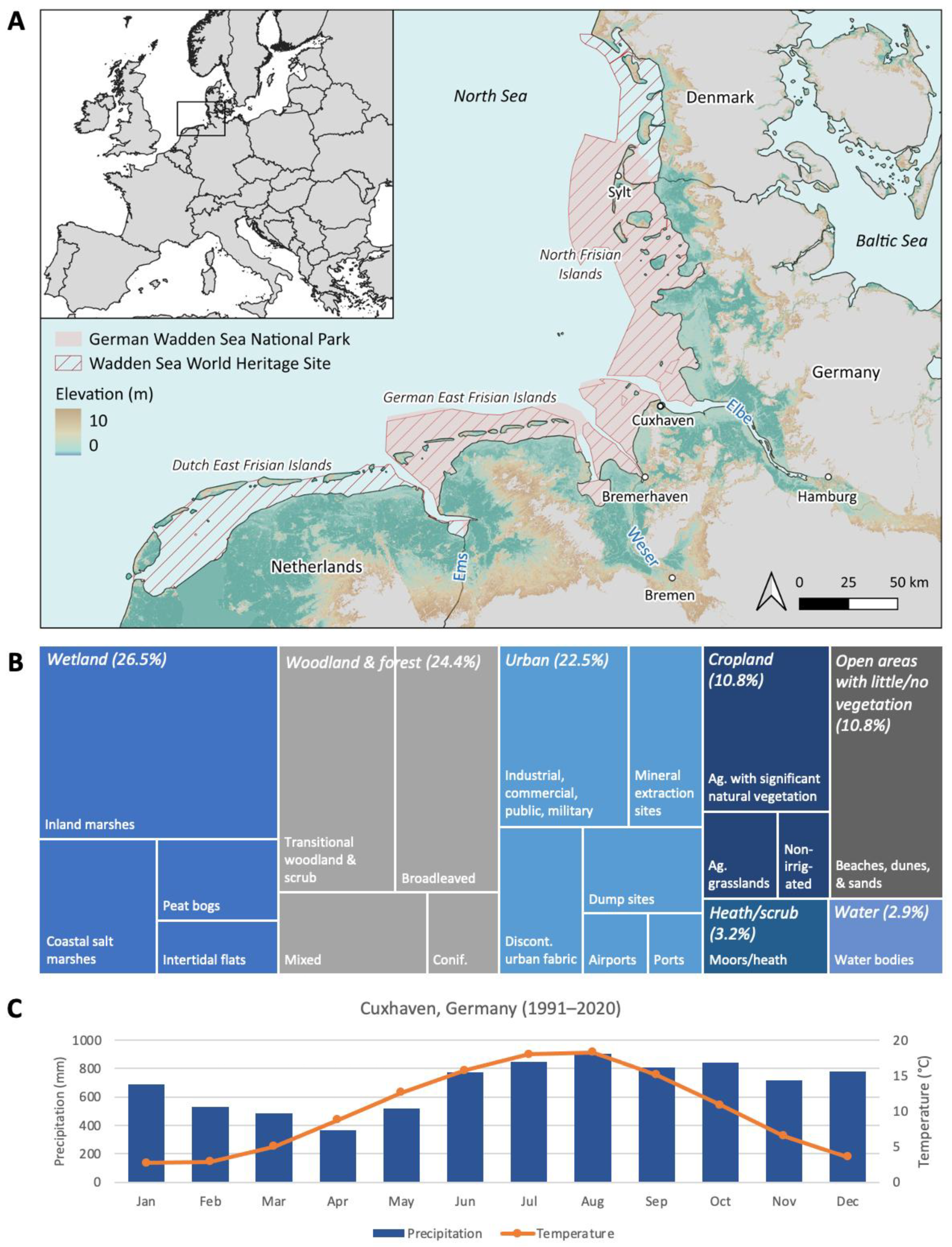


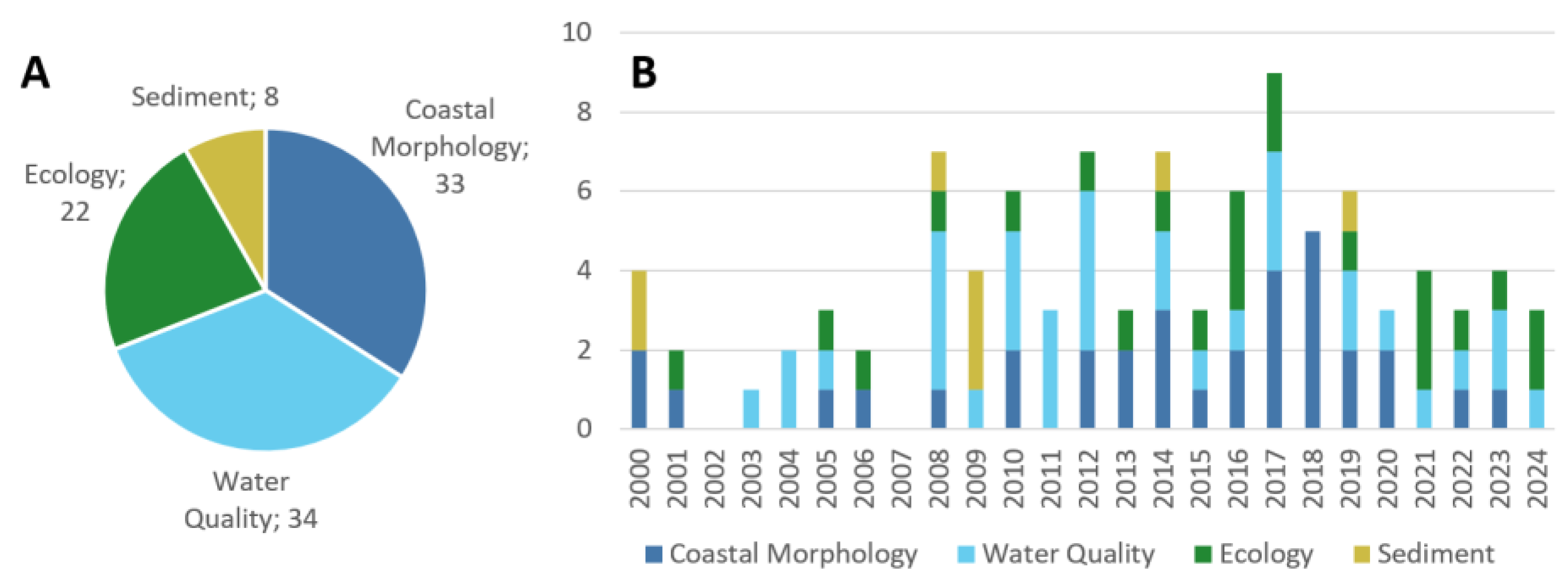
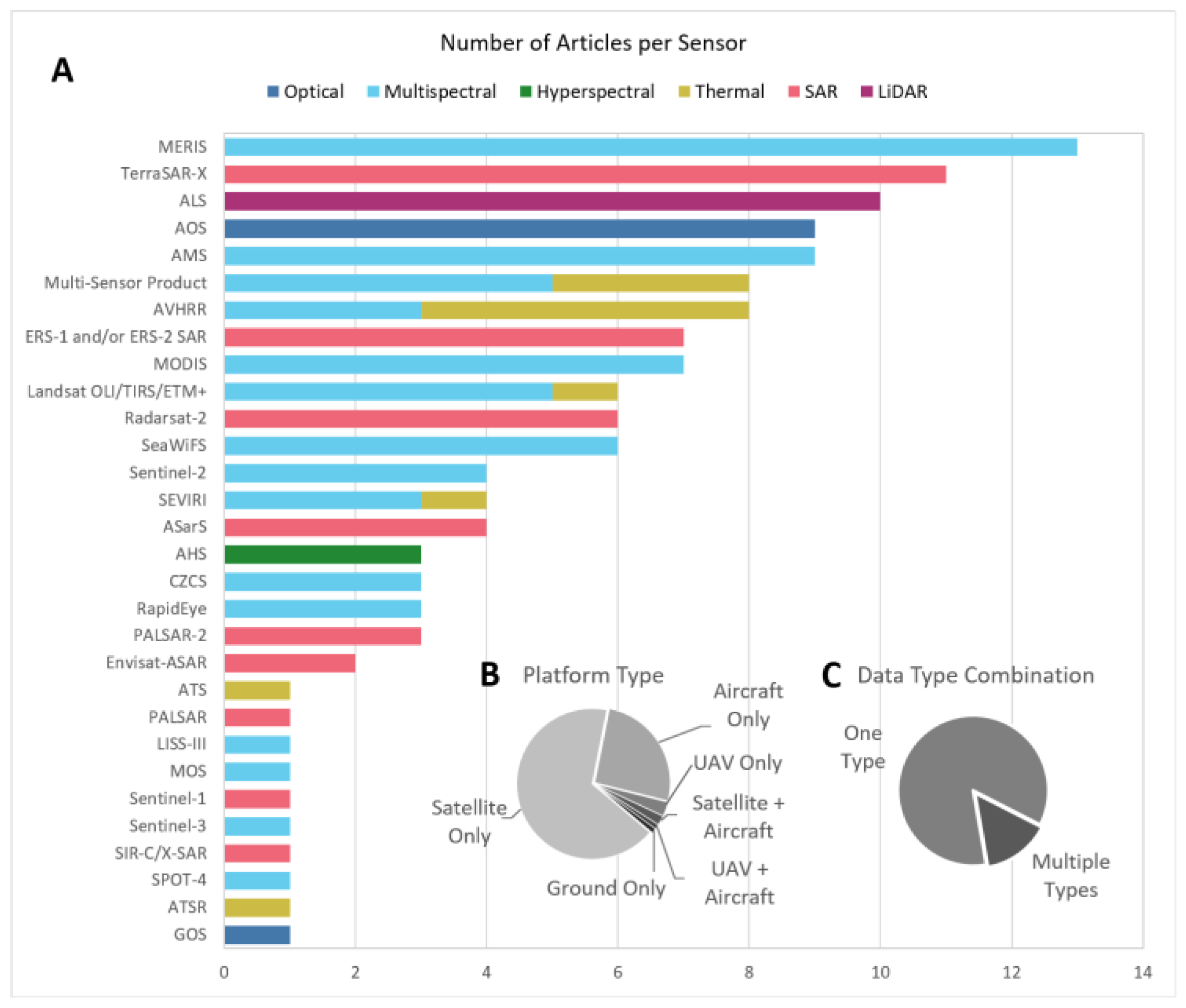




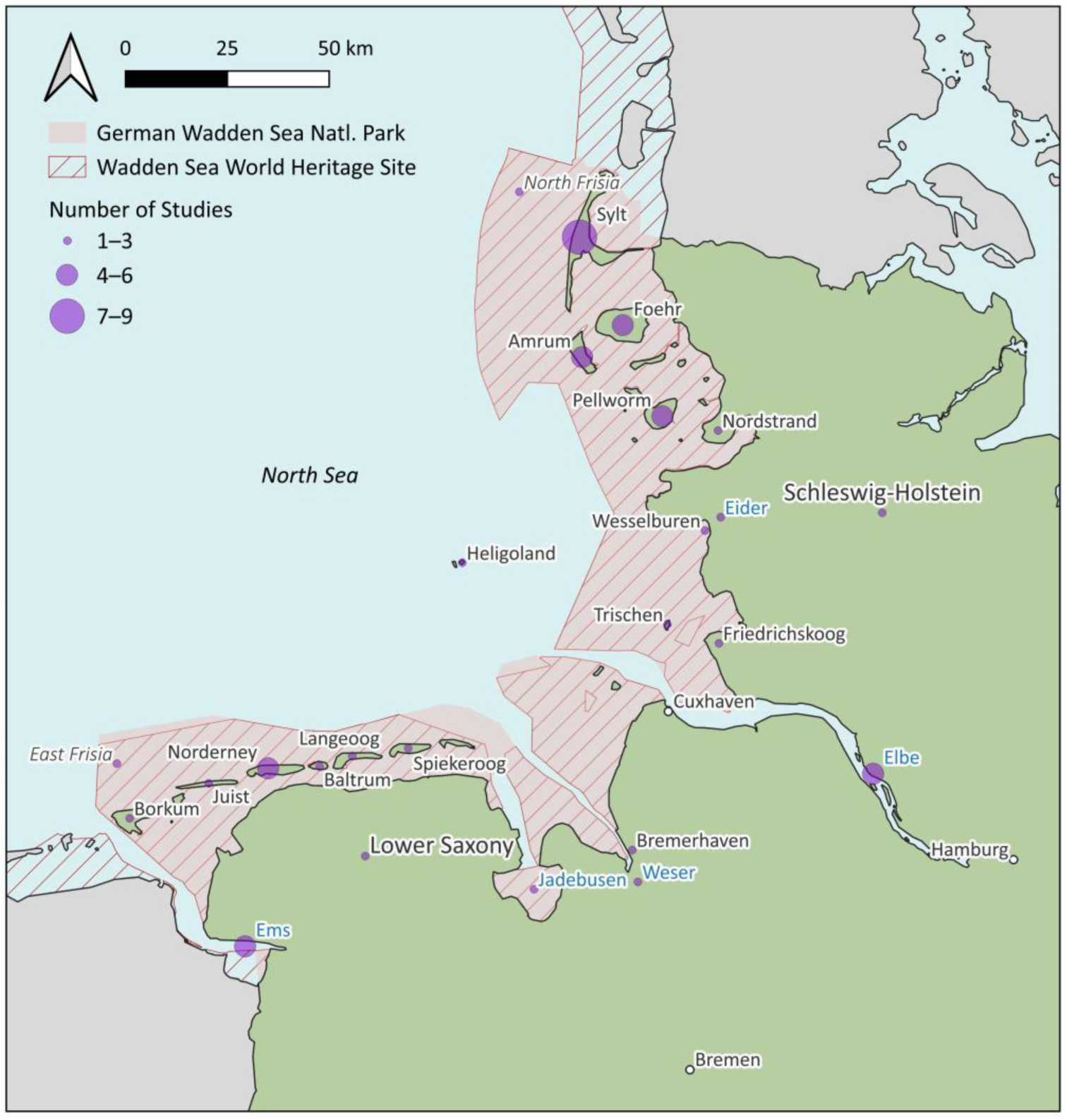
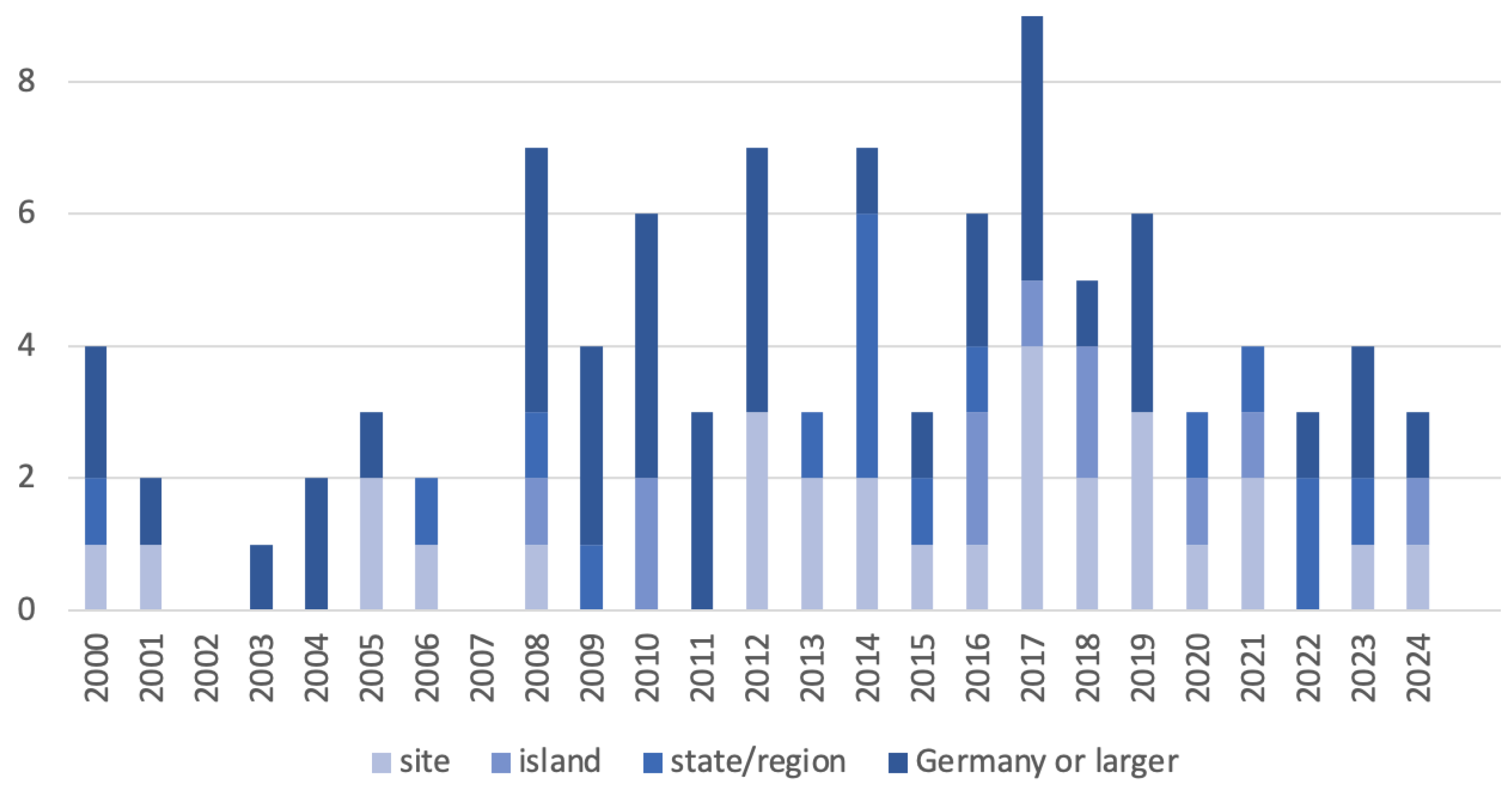
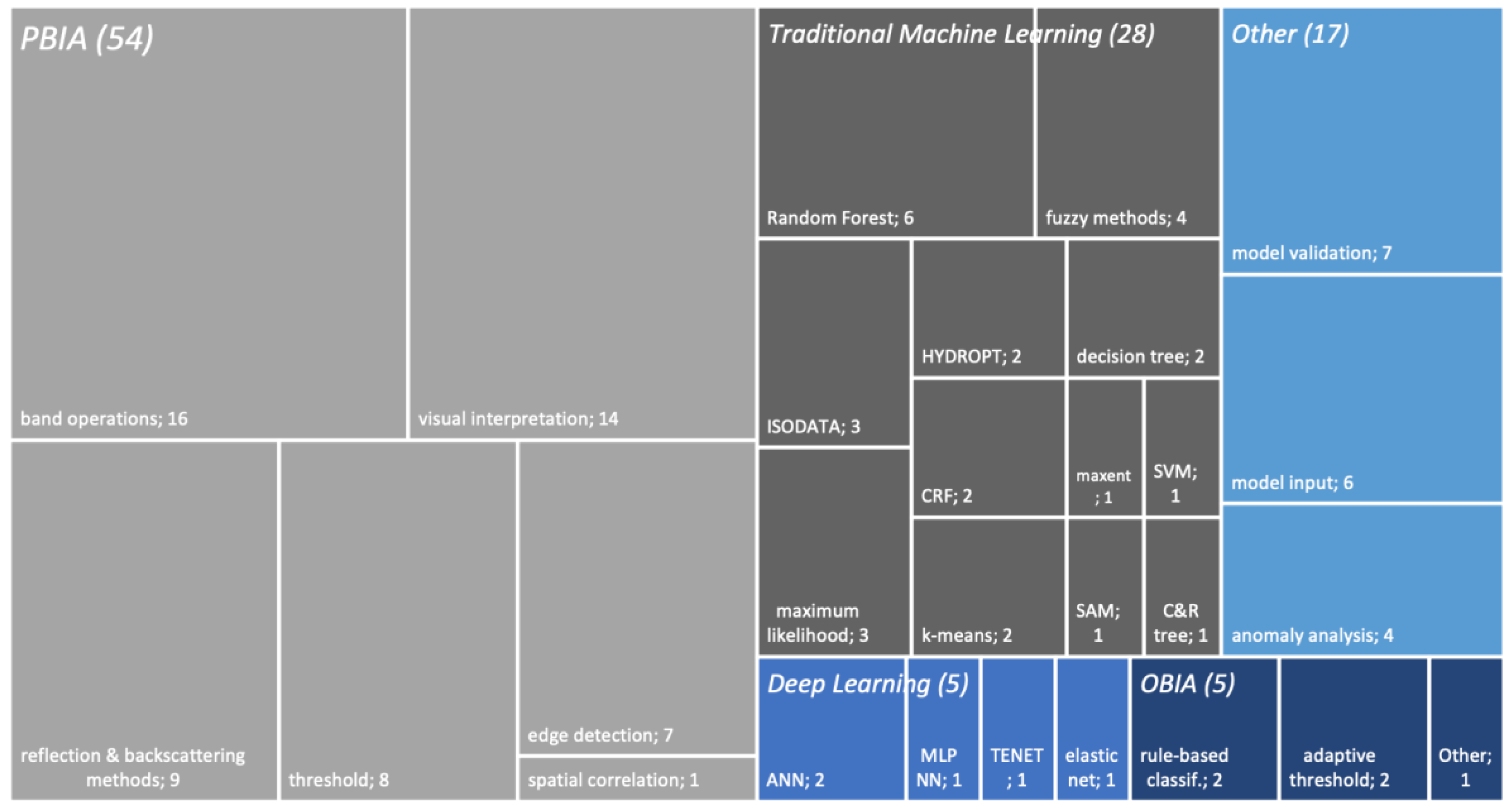
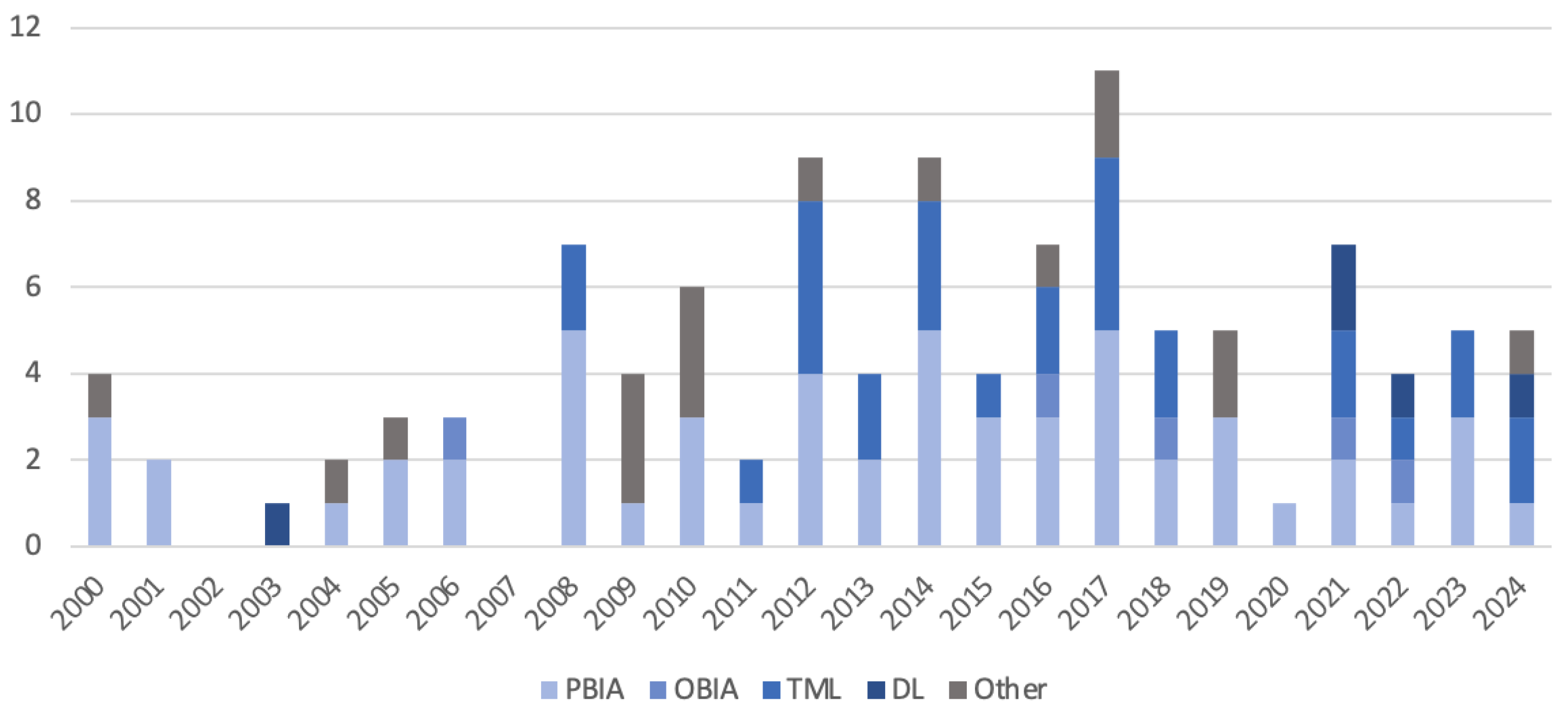
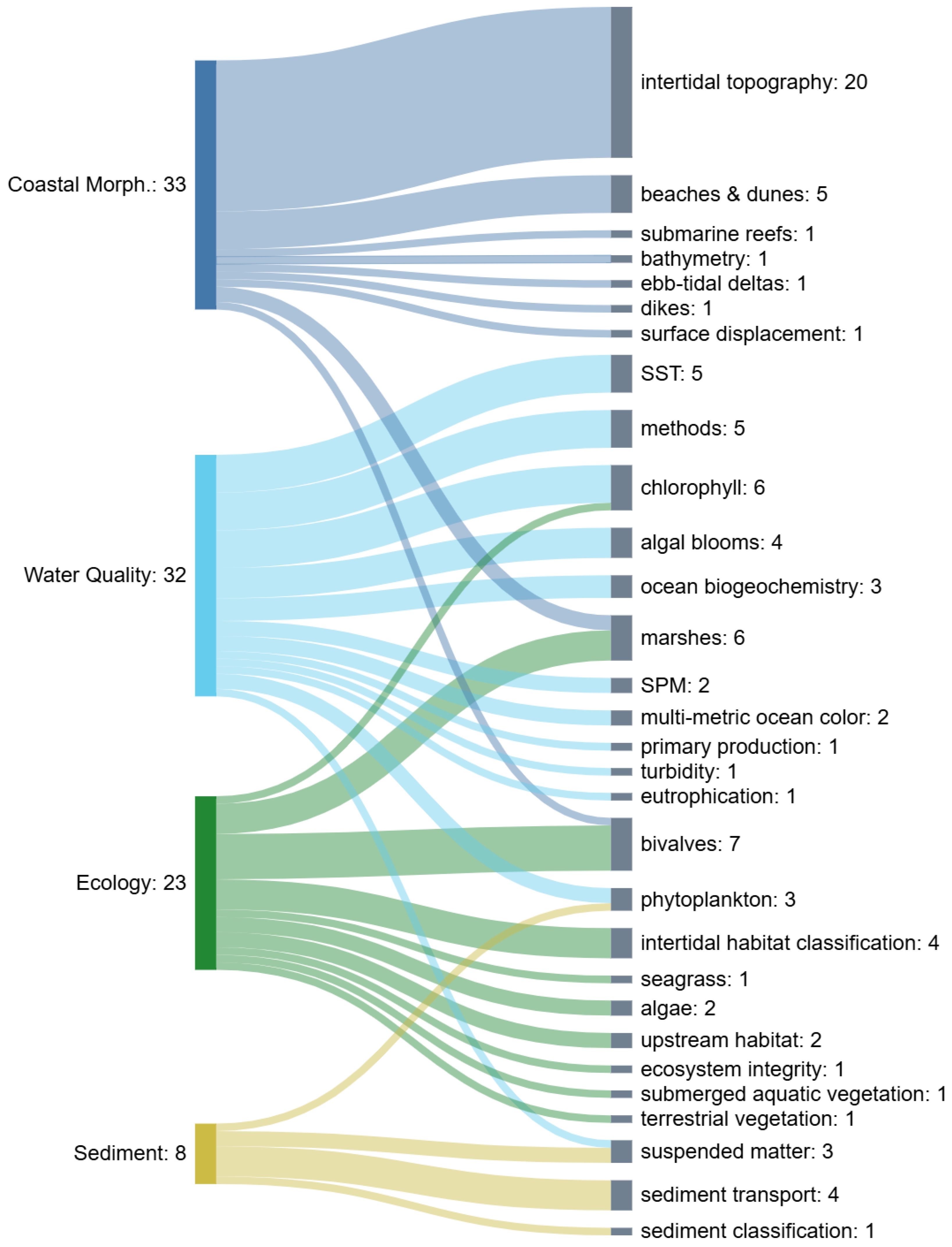
| Journal | Articles per Journal |
|---|---|
| Remote Sensing of Environment | 11 |
| Remote Sensing | 10 |
| Journal of Sea Research | 6 |
| Ocean Dynamics | 6 |
| Estuarine Coastal and Shelf Science | 5 |
| IEEE Transactions on Geoscience and Remote Sensing | 5 |
| Geo-Marine Letters | 4 |
| Frontiers in Marine Science | 3 |
| Science of the Total Environment | 3 |
| Continental Shelf Research | 3 |
Disclaimer/Publisher’s Note: The statements, opinions and data contained in all publications are solely those of the individual author(s) and contributor(s) and not of MDPI and/or the editor(s). MDPI and/or the editor(s) disclaim responsibility for any injury to people or property resulting from any ideas, methods, instructions or products referred to in the content. |
© 2025 by the authors. Licensee MDPI, Basel, Switzerland. This article is an open access article distributed under the terms and conditions of the Creative Commons Attribution (CC BY) license (https://creativecommons.org/licenses/by/4.0/).
Share and Cite
Alvarez, K.R.; Bachofer, F.; Kuenzer, C. Potential of Earth Observation for the German North Sea Coast—A Review. Remote Sens. 2025, 17, 1073. https://doi.org/10.3390/rs17061073
Alvarez KR, Bachofer F, Kuenzer C. Potential of Earth Observation for the German North Sea Coast—A Review. Remote Sensing. 2025; 17(6):1073. https://doi.org/10.3390/rs17061073
Chicago/Turabian StyleAlvarez, Karina Raquel, Felix Bachofer, and Claudia Kuenzer. 2025. "Potential of Earth Observation for the German North Sea Coast—A Review" Remote Sensing 17, no. 6: 1073. https://doi.org/10.3390/rs17061073
APA StyleAlvarez, K. R., Bachofer, F., & Kuenzer, C. (2025). Potential of Earth Observation for the German North Sea Coast—A Review. Remote Sensing, 17(6), 1073. https://doi.org/10.3390/rs17061073










